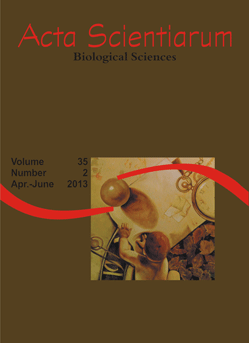<b>Feeding of larvae of the hybrid surubim <i>Pseudoplatystoma</i> sp. under two conditions of food management</b> - doi: 10.4025/actascibiolsci.v35i2.15359
Keywords:
larviculture, freshwater fish, diet
Abstract
We evaluated the growth and diet composition of hybrid surubim larvae (Pseudoplatystoma corruscans x P. reticulatum) produced in two fish farming by using different systems of feeding with natural plankton: M I, larvae are transferred to fertilized fish pond for being freely fed with natural plankton; M II, larvae are remained inside laboratory in glass fiber boxes and plankton are gathered with a plankton net and offered in a controlled way. It was collected 10 individuals daily during the feeding period with live plankton for 20 days. After the biometry, stomachs were opened and the food items identified and quantified by the volumetric method. The items were represented by algae, protozoa, microcrustacean, insect larvae and surubim fragments (cannibalism). The items with higher volumetric percentage were Chironomidae larvae (29.25%) followed by surubim fragments (19.68%) in M I, and surubim fragments (21.85%) and Moina micrura (19.97%) in MII. The items Chydorus sp., Diaphanosoma sp., sp. Macrothrix and Ephemeroptera larvae were found only in fish of M I, while algae Ulothrix sp., Oscillatoria sp. and the protozoa Difflugia sp were only found in stomachs of surubim from M II. Regarding the growth, the surubim had grown faster in M I.Downloads
Download data is not yet available.
Published
2012-12-20
How to Cite
Silva, A. F. L. da, Russo, M. R., Ramos, L. de A., & Rocha, A. S. (2012). <b>Feeding of larvae of the hybrid surubim <i>Pseudoplatystoma</i> sp. under two conditions of food management</b> - doi: 10.4025/actascibiolsci.v35i2.15359. Acta Scientiarum. Biological Sciences, 35(2), 149-155. https://doi.org/10.4025/actascibiolsci.v35i2.15359
Issue
Section
Aquiculture and Fisheries Resources
DECLARATION OF ORIGINALITY AND COPYRIGHTS
I Declare that current article is original and has not been submitted for publication, in part or in whole, to any other national or international journal.
The copyrights belong exclusively to the authors. Published content is licensed under Creative Commons Attribution 4.0 (CC BY 4.0) guidelines, which allows sharing (copy and distribution of the material in any medium or format) and adaptation (remix, transform, and build upon the material) for any purpose, even commercially, under the terms of attribution.
Read this link for further information on how to use CC BY 4.0 properly.
0.6
2019CiteScore
31st percentile
Powered by 

0.6
2019CiteScore
31st percentile
Powered by 











1.png)




3.png)













